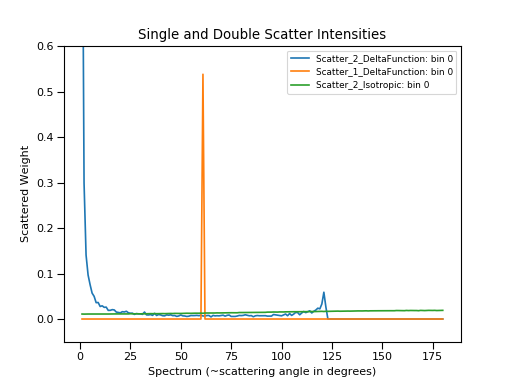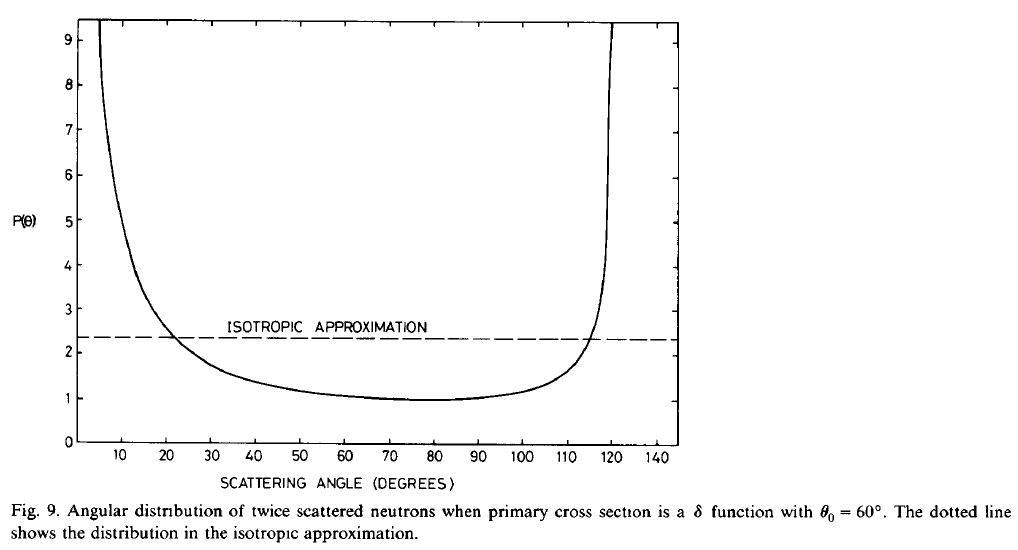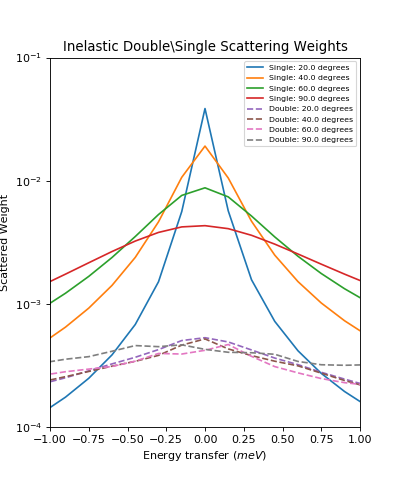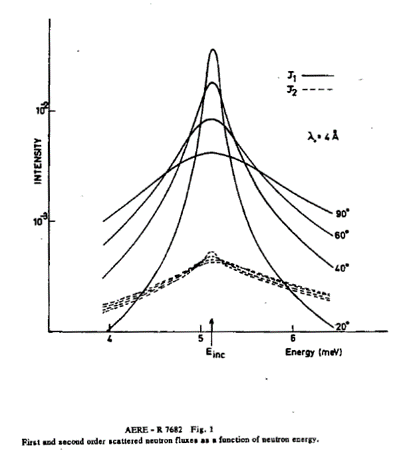\(\renewcommand\AA{\unicode{x212B}}\)
Table of Contents
Calculates a multiple scattering correction using a Monte Carlo method
MayersSampleCorrection, CarpenterSampleCorrection, VesuvioCalculateMS
This algorithm is also known as: Muscat
| Name | Direction | Type | Default | Description |
|---|---|---|---|---|
| InputWorkspace | Input | MatrixWorkspace | Mandatory | The name of the input workspace. The input workspace must have X units of Momentum (k) for elastic calculations and units of energy transfer (DeltaE) for inelastic calculations. This is used to supply the sample details, the detector positions and the x axis range to calculate corrections for |
| StructureFactorWorkspace | Input | MatrixWorkspace | Mandatory | The name of the workspace containing S’(q) or S’(q, w). For elastic calculations, the input workspace must contain a single spectrum and have X units of momentum transfer. |
| OutputWorkspace | Output | WorkspaceGroup | Mandatory | Name for the WorkspaceGroup that will be created. Each workspace in the group contains a calculated weight for a particular number of scattering events. The number of scattering events varies from 1 up to the number supplied in the NumberOfScatterings parameter. The group will also include an additional workspace for a calculation with a single scattering event where the absorption post scattering has been set to zero |
| ScatteringCrossSection | Input | MatrixWorkspace | A workspace containing the scattering cross section as a function of k, \(\sigma_s(k)\). Note - this parameter would normally be left empty which results in the tabulated cross section data being used instead which implies no wavelength dependence | |
| NumberOfSimulationPoints | Input | number | Optional | The number of points on the input workspace x axis for which a simulation is attempted |
| NeutronPathsSingle | Input | number | 1000 | The number of “neutron” paths to generate for single scattering |
| NeutronPathsMultiple | Input | number | 1000 | The number of “neutron” paths to generate for multiple scattering |
| SeedValue | Input | number | 123456789 | Seed the random number generator with this value |
| NumberScatterings | Input | number | 2 | Number of scatterings |
| Interpolation | Input | string | Linear | Method of interpolation used to compute unsimulated values. Allowed values: [‘Linear’, ‘CSpline’] |
| SparseInstrument | Input | boolean | False | Enable simulation on special instrument with a sparse grid of detectors interpolating the results to the real instrument. |
| NumberOfDetectorRows | Input | number | 5 | Number of detector rows in the detector grid of the sparse instrument. |
| NumberOfDetectorColumns | Input | number | 10 | Number of detector columns in the detector grid of the sparse instrument. |
| ImportanceSampling | Input | boolean | False | Enable importance sampling on the Q value chosen on multiple scatters based on Q.S(Q) |
| MaxScatterPtAttempts | Input | number | 5000 | Maximum number of tries made to generate a scattering point within the sample. Objects with holes in them, e.g. a thin annulus can cause problems if this number is too low. If a scattering point cannot be generated by increasing this value then there is most likely a problem with the sample geometry. |
| SimulateEnergiesIndependently | Input | boolean | False | For inelastic calculation, whether the results for adjacent energy transfer bins are simulated separately. Currently applies to Direct geometry only |
This algorithm calculates a Multiple Scattering correction using a Monte Carlo integration method. The method uses a structure function for the sample to determine the probability of a particular momentum transfer (q) and energy transfer (\(\omega\)) value for each scattering event and it doesn’t therefore rely on an assumption that the scattering is isotropic.
The structure function that the algorithm takes as input is a linear combination of the coherent and incoherent structure factors:
\(S'(Q, \omega) = \frac{1}{\sigma_b}(\sigma_{coh} S(Q, \omega) + \sigma_{inc} S_s(Q, \omega))\)
If the sample is a perfectly coherent scatterer then \(S'(Q, \omega) = S(Q, \omega)\)
The algorithm is based on code which was originally written in Fortran as part of the Discus program [1]. The code was subsequently resurrected and improved by Spencer Howells under the Muscat name and was included in the QENS MODES package [2] These original programs calculated multiple scattering corrections for inelastic instruments but an elastic diffraction version of the code was also created and results from that program are included in this paper by Mancinelli [3].
The theory is outlined here for an inelastic calculation. The calculation performed for an elastic instrument is a special case of this with \(\omega=0\).
The algorithm calculates a set of dimensionless weights \(J_n\) describing the probability of detection at an angle \(\theta\) after n scattering events given a total incident flux \(I_0\) and a transmitted flux of T:
\(T_n(\theta,k_{in}, \omega) = J_n(\theta,k_{in}, \omega) I_0(k_{in})\)
The quantity \(J_n\) is calculated by performing the following integration:
The variables \(l_i^{max}\) represent the maximum path length before the next scatter given a particular phi and theta value (Q). Each \(l_i\) is actually a function of all of the earlier values for the \(l_i\), \(\phi\) and \(Q\) variables ie \(l_i = l_i(l_1, l_2, ..., l_{i-1}, \phi_1, \phi_2, ..., \phi_i, Q_1, Q_2, ..., Q_i)\). The limits on the \(\omega\) integration are a minimum based on the range of values supplied in the \(S(Q, \omega)\) profile and a maximum which is a function of i equal to the total energy loss of the pre-scatter neutron. The limits on the q integration are also a function of i as follows. These formulae for the limits reduce to 0 and 2k for elastic.
\(q_i^{min} = |k_{i+1} - k_i|\)
\(q_i^{max} = q_i^{min} + 2 min(k_i, k_{i+1})\)
The following substitutions are then performed in order to make it more convenient to evaluate as a Monte Carlo integral:
\(t_i = \frac{1-e^{-\mu_T l_i}}{1-e^{-\mu_T l_i^{max}}}\)
\(u_i = \frac{\phi_i}{2 \pi}\)
\(2 k_i^2 = \frac{\sigma_S}{\sigma_s(k_i)} \int_{w_i^{min}}^{w_i^{max}} \int_{q_i^{min}}^{q_i^{max}} Q_i S(Q_i, \omega_i) dQ_i d\omega_i\)
Using the new variables the integral is:
This is evaluated as a Monte Carlo integration by selecting random values for the variables \(t_i\) and \(u_i\) between 0 and 1 and values for \(Q_i\) between \(q_i^{min}\) and \(q_i^{max}\). A simulated path is traced through the sample to enable the \(l_i^{\ max}\) values to be calculated. The path is traced by calculating the \(l_i\), \(\theta\) and \(\phi\) values as follows from the random variables. The code keeps a note of the start coordinates of the current path segment and updates it when moving to the next segment using these randomly selected lengths and directions:
\(l_i = -\frac{1}{\mu_T}ln(1-(1-e^{-\mu_T l_i^{\ max}})t_i)\)
\(\cos\theta_i = (k_i^2 + k_{i+1}^2 - Q_i^2)/2 k_i k_{i+1}\)
\(\phi_i = 2 \pi u_i\)
The final Monte Carlo integration that is actually performed by the code is as follows where N is the number of scenarios:
The purpose of replacing \(2 k^2\) with \(\int Q S(Q) dQ\) can now be seen because it avoids the need to multiply by an integration range across \(dQ\) when converting the integral to a Monte Carlo integration. This is useful in the inelastic version of this algorithm where the integration of the structure factor is over two dimensions \(Q\) and \(\omega\) and the area of \(Q\omega\) space that has been integrated over is less obvious.
This is similar to the formulation described in the Mancinelli paper except there is no random variable to decide whether a particular scattering event is coherent or incoherent.
The results for different \(\omega\) values can be calculated by simulating tracks separately for each \(\omega\) value or the same tracks can be reused with the multiple weights for the final track segment being calculated to achieve the required range of overall energy transfers. Discus used the latter approach which results in the results for different \(\omega\) being correlated. This choice is controlled using the “SimulateEnergiesIndependently” parameter
The algorithm includes an option to use importance sampling to improve the results for elastic instrument when running with S(Q) profiles containing spikes. Without this option enabled, the contribution from rare, high values in the structure factor is only visible at a very high number of scenarios.
The importance sampling is achieved using a further change of variables as follows:
\(v_i = P(Q_i) = \frac{I(Q_i)}{I(2k)}\) where \(I(x) = \int_{0}^{x} Q S(Q) dQ\)
With this approach the Q value for each segment is chosen as follows based on a \(v_i\) value randomly selected between 0 and 1:
\(Q_i = P^{-1}(v_i)\)
\(\cos\theta_i\) is determined from \(Q_i\) as before. The change of variables gives the following integral for \(J_n\):
Finally, the equivalent Monte Carlo integration that the algorithm performs with importance sampling enabled is:
The importance sampling has also been implemented for inelastic instruments by flatting out the 2D \(S(Q, \omega)\) profile into a 1D array. A 1D coordinate is created which is the actual Q value added onto the maximum Q from the preceding \(\omega\) row: \(Q'(Q,\omega_i) = Q + Q_{max}(\omega_{i-1})\) With this approach there is no interpolation performed between different \(\omega\) values. It’s not clear whether the importance sampling is useful for inelastic calculations since the area where the multiple scattering correction tends to be largest relative to the signal is away from the peak in \(S(Q, \omega)\).
The algorithm outputs a workspace group containing the following workspaces:
Scatter_n where n is the number of scattering events considered. Each workspace contains “per detector” weights as a function of momentum or energy transfer for a specific number of scattering events. The number of scattering events ranges between 1 and the number specified in the NumberOfScatterings parameterScatter_n_Integrated which are integrals of the Scatter_n workspaces across the x axis (Momentum for elastic and DeltaE for inelastic)Scatter_1_NoAbsorb is also created for a scenario where neutrons are scattered once, absorption is assumed to be zero and re-scattering after the simulated scattering event is assumed to be zero. This is the quantity \(J_{1}^{*}\) described in the Discus manualScatter_2_n_Summed which is the sum of the Scatter_n workspaces for n > 1Scatter_1_n_Summed which is the sum of the Scatter_n workspaces for n >= 1Ratio_Single_To_All which is the Scatter_1 workspace divided by Scatter_1_n_SummedThe output can be applied to a workspace containing a real sample measurement in one of two ways:
The multiple scattering correction should be applied before applying an absorption correction.
The Discus manual describes a further method of applying an attenuation correction and a multiple scattering correction in one step using a variation of the factor method. To achieve this the real sample measurement should be multipled by \(J_1^{*}/(\sum_{n=1}^{\infty} J_n\)). Note that this differs from the approach taken in other Mantid absorption correction algorithms such as MonteCarloAbsorption because of the properties of \(J_{1}^{*}\). \(J_{1}^{*}\) corrects for attenuation due to absorption before and after the simulated scattering event (which is the same as MonteCarloAbsorption) but it only corrects for attenuation due to scattering after the simulated scattering event. For this reason it’s not clear this feature from Discus is useful but it has been left in for historical reasons.
The sample shape can be specified by running the algorithms SetSample or LoadSampleShape on the input workspace prior to running this algorithm.
The algorithm can take a long time to run on instruments with a lot of spectra andor a lot of bins in each spectrum. The run time can be reduced by enabling the following interpolation features:
Both of these interpolation features are described further in the documentation for the MonteCarloAbsorption algorithm
Example - elastic calculation on single spike S(Q) and an isotropic S(Q) for comparison
# import mantid algorithms, numpy and matplotlib
from mantid import mtd
from mantid.simpleapi import *
import matplotlib.pyplot as plt
import numpy as np
# S(Q) consisting of single spike at q=1
# Spike height gives same normalisation as isotropic (integral of Q.S(Q) the same)
X=[0.99,1.0,1.01]
Y=[0.,100,0.]
Sofq=CreateWorkspace(DataX=X,DataY=Y,UnitX="MomentumTransfer")
# Isotropic S(Q)
X=[1.0]
Y=[1.0]
Sofq_isotropic=CreateWorkspace(DataX=X,DataY=Y,UnitX="MomentumTransfer")
two_thetas=[]
for i in range(180):
two_thetas.append(i)
# workspace with single bin centred at k=1 Angstrom-1
ws = CreateSampleWorkspace(WorkspaceType="Histogram",
XUnit="Momentum",
Xmin=0.5,
Xmax=1.5,
BinWidth=1.0,
NumBanks=len(two_thetas)//4,
BankPixelWidth=2,
InstrumentName="testinst")
ids = list(range(1,len(two_thetas)+1))
EditInstrumentGeometry(ws,
PrimaryFlightPath=14.0,
SpectrumIDs=ids,
L2=[2.0] * len(two_thetas),
Polar=two_thetas,
Azimuthal=[90.0] * len(two_thetas),
DetectorIDs=ids,
InstrumentName="testinst")
sphere_xml = " \
<sphere id='some-sphere'> \
<centre x='0.0' y='0.0' z='0.0' /> \
<radius val='0.01' /> \
</sphere> \
<algebra val='some-sphere' /> \
"
SetSample(InputWorkspace=ws,
Geometry={'Shape': 'CSG', 'Value': sphere_xml},
Material={'NumberDensity': 0.02, 'AttenuationXSection': 0.0,
'CoherentXSection': 0.0, 'IncoherentXSection': 0.0, 'ScatteringXSection': 80.0})
results_group = DiscusMultipleScatteringCorrection(InputWorkspace=ws, StructureFactorWorkspace=Sofq,
OutputWorkspace="MuscatResults", NeutronPathsSingle=1000,
NeutronPathsMultiple=10000, ImportanceSampling=True)
# Can't index into workspace group by name (yet) so just get the members from the ADS instead
Scatter_1_DeltaFunction = CloneWorkspace('MuscatResults_Scatter_1')
Scatter_2_DeltaFunction = CloneWorkspace('MuscatResults_Scatter_2')
DeleteWorkspace('MuscatResults')
DiscusMultipleScatteringCorrection(InputWorkspace=ws, StructureFactorWorkspace=Sofq_isotropic,
OutputWorkspace="MuscatResultsIsotropic", NeutronPathsSingle=1000,
NeutronPathsMultiple=10000, ImportanceSampling=True)
Scatter_2_Isotropic = CloneWorkspace('MuscatResultsIsotropic_Scatter_2')
# q=2ksin(theta), so q spike corresonds to single scatter spike at ~60 degrees, double scatter spikes at 0 and 120 degrees
msplot = plotBin('Scatter_2_DeltaFunction',0)
msplot = plotBin('Scatter_1_DeltaFunction',0, window=msplot)
msplot = plotBin('Scatter_2_Isotropic',0, window=msplot)
axes = plt.gca()
axes.set_xlabel('Spectrum (~scattering angle in degrees)')
axes.set_ylim(-0.05,0.6)
plt.title("Single and Double Scatter Intensities")
mtd.clear()
(Source code, png, hires.png, pdf)

The double scatter profile shows a similar shape to the analytic result calculated in [4]:

Example - inelastic calculation on direct geometry (matches calculation in DISCUS paper [1] figure 1)
# import mantid algorithms, numpy and matplotlib
from mantid.simpleapi import *
import matplotlib.pyplot as plt
import numpy as np
import math
# parameterised Lorentzian S(Q,w) from Discus pdf
# wavelength = 4 Angstroms, k=1.57
X,Y, SpecAxis =[],[],[]
qmin, qmax = 0.,4.0
nqpts = 9
wmin, wmax = -5.85, 5.85 # meV
nwpts = 79 # negative w is given explicitly so ~double number of pts in Discus
D = 0.15 # Angstom-2 meV -1 = 2.3E-05 cm2 s-1
TEMP=300
HOVERT = 11.6087/TEMP
for iq in range(nqpts):
q = iq * (qmax-qmin)/(nqpts-1) + qmin
SpecAxis.append(q)
for iw in range(nwpts):
w = iw * (wmax-wmin)/(nwpts-1) + wmin
X.append(w)
if (w*w + (D*q*q)**2==0.):
# Discus S(Q,w) has zero here so do likewise
print("Denominator zero so outputting S(q,w)=0")
Y.append(0.)
else:
Sqw = D*q*q/(math.pi*(w*w + (D*q*q)**2))
# Apply detailed balance, neutrons more likely to lose energy in each scatter
# Mantid has w = Ei-Ef
if (w > 0.):
Sqw = Sqw * math.exp(HOVERT * w)
# S(Q,w) is capped at exactly 4.0 for some reason in Discus example
Y.append(min(Sqw,4.0))
sqw = CreateWorkspace(DataX=X,DataY=Y,UnitX="DeltaE",
VerticalAxisUnit="MomentumTransfer",
VerticalAxisValues=SpecAxis, NSpec=nqpts)
two_thetas = [20.0, 40.0, 60.0, 90.0]
ws = CreateSampleWorkspace(WorkspaceType="Histogram",
XUnit="DeltaE",
Xmin=wmin-0.5*(wmax-wmin)/(nwpts-1),
Xmax=wmax+0.5*(wmax-wmin)/(nwpts-1),
BinWidth=(wmax-wmin)/(nwpts-1),
NumBanks=len(two_thetas),
BankPixelWidth=1,
InstrumentName="testinst")
# set up ring of detectors in yz plane
ids = list(range(1,len(two_thetas)+1))
EditInstrumentGeometry(ws,
PrimaryFlightPath=14.0,
SpectrumIDs=ids,
L2=[2.0] * len(two_thetas),
Polar=two_thetas,
#azimuthal angle=phi, phi=0 along x axis and increases as move towards vertical y axis
Azimuthal=[-90.0] * len(two_thetas),
DetectorIDs=ids,
InstrumentName="testinst")
# flat plate sample 5cm x 5cm x 0.065cm
cuboid_xml = " \
<cuboid id='flatplate'> \
<width val='0.05' /> \
<height val='0.05' /> \
<depth val='0.00065' /> \
<centre x='0.0' y='0.0' z='0.0' /> \
<rotate x='45' y='0' z='0' /> \
</cuboid> \
"
SetSample(InputWorkspace=ws,
Geometry={'Shape': 'CSG', 'Value': cuboid_xml},
Material={'NumberDensity': 0.02, 'AttenuationXSection': 0.0,
'CoherentXSection': 0.0, 'IncoherentXSection': 0.0, 'ScatteringXSection': 80.0})
#match Ei value from DISCUS pdf Figure 1
ws.run().addProperty("deltaE-mode", "Direct", True);
ws.run().addProperty("Ei", 5.1, True);
DiscusMultipleScatteringCorrection(InputWorkspace=ws, StructureFactorWorkspace=sqw,
OutputWorkspace="MuscatResults", NeutronPathsSingle=200,
NeutronPathsMultiple=1000)
# reverse w axis because Discus w = Ef-Ei (opposite to Mantid)
for i in range(mtd['MuscatResults_Scatter_1'].getNumberHistograms()):
y = np.flip(mtd['MuscatResults_Scatter_1'].dataY(i),0)
mtd['MuscatResults_Scatter_1'].setY(i,y.tolist())
for i in range(mtd['MuscatResults_Scatter_2'].getNumberHistograms()):
y = np.flip(mtd['MuscatResults_Scatter_2'].dataY(i),0)
mtd['MuscatResults_Scatter_2'].setY(i,y.tolist())
plt.rcParams['figure.figsize'] = (5, 6)
fig, ax = plt.subplots(subplot_kw={'projection':'mantid'})
for i, tt in enumerate(two_thetas):
ax.plot(mtd['MuscatResults_Scatter_1'], wkspIndex=i, label='Single: ' + str(tt) + ' degrees')
for i, tt in enumerate(two_thetas):
ax.plot(mtd['MuscatResults_Scatter_2'], wkspIndex=i, label='Double: ' + str(tt) + ' degrees', linestyle='--')
plt.yscale('log')
ax.set_xlim(-1,1)
ax.set_ylim(1e-4,1e-1)
ax.legend(fontsize=7.0)
plt.title("Inelastic Double\\Single Scattering Weights")
fig.show()
mtd.clear()
(Source code, png, hires.png, pdf)

This is the equivalent plot from the original Discus Fortran program:

| [1] | (1, 2) M W Johnson, 1974 AERE Report R7682, Discus: A computer program for the calculating of multiple scattering effects in inelastic neutron scattering experiments |
| [2] | WS Howells, V Garcia Sakai, F Demmel, MTF Telling, F Fernandez-Alonso, Feb 2010, MODES manual RAL-TR-2010-006, doi: 10.5286/raltr.2010006 |
| [3] | R Mancinelli 2012 J. Phys.: Conf. Ser. 340 012033, Multiple neutron scattering corrections. Some general equations to do fast evaluations doi: 10.1088/1742-6596/340/1/012033 |
| [4] | J Mayers, R Cywinski, 1985 Nuclear Instruments and Methods in Physics Research A241, A Monte Carlo Evaluation Of Analytical Multiple Scattering Corrections For Unpolarised Neutron Scattering And Polarisation Analysis Data doi: 10.1016/0168-9002(85)90607-2 |
Categories: AlgorithmIndex | CorrectionFunctions
C++ header: DiscusMultipleScatteringCorrection.h
C++ source: DiscusMultipleScatteringCorrection.cpp